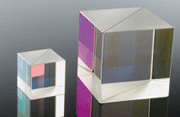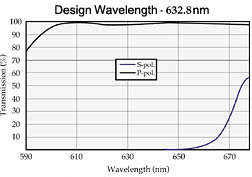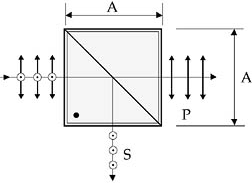|
Polarizing cube beamsplitters divide unpolarized light into two orthogonal polarized beams at 90° to each other. The transmitted beam is mostly polarized parallel to the plane of incidence (p-polarized), and the reflected beam is mostly polarized perpendicular to the plane of incidence. Each beamsplitter consists of a pair of precision high tolerance right angle prisms, which must be fixed in relation to one another by either mounting or cement. A multi-layer antireflective coating is then applied to each face of the beamsplitter in order to produce maximum transmission efficiency. |
  |
||
|
|||
|
There are three main types of polarizing cube beamsplitters: prism, broadband, and laser-line. Prism cube beamsplitters are constructed by cementing together two precision right angle prisms with the appropriate interference coating on the hypotenuse surface. This is the most common style of polarizing cube beamsplitters. Broadband cube beamsplitters operate in the visible and very near infrared (to 850 nm) with constant performance over a 200 nm range. Laser-line cube beamsplitters are tuned for optimum performance at specific laser wavelengths. They exhibit lower loss, but have a narrower operating range, typically 25 nm or less. |
|||
|
Since polarizing cube beamsplitters use reflection to polarize the light, the materials from which the cubes are made are less bifringent than those used in other types of polarizers. The materials tend to be oriented more towards bandpass. Some of the more common materials used in the creation of polarizing beamsplitter cubes are BK7 glass, SF2 Glass, and UV grade fused silica; although custom and proprietary material styles can also be found. BK7 Glass is boro-crown glass (borosilicate glass). It has a wavelength range of 330-2100 nm. SF2 Glass is dense flint (alkaline silicate glasses with 47% wt. PbO). UV grade fused silica offers improved transmission in the ultraviolet region when compared to crown glass. Its wavelength range is 200-2500 nm. |
|||
|
Only collimated beams of light can be used with polarizing cube beamsplitters. A shear plate may be used to make sure that an expanded beam is properly collimated before striking the cube. |
|||
Polarizing Cube Beamsplitters


